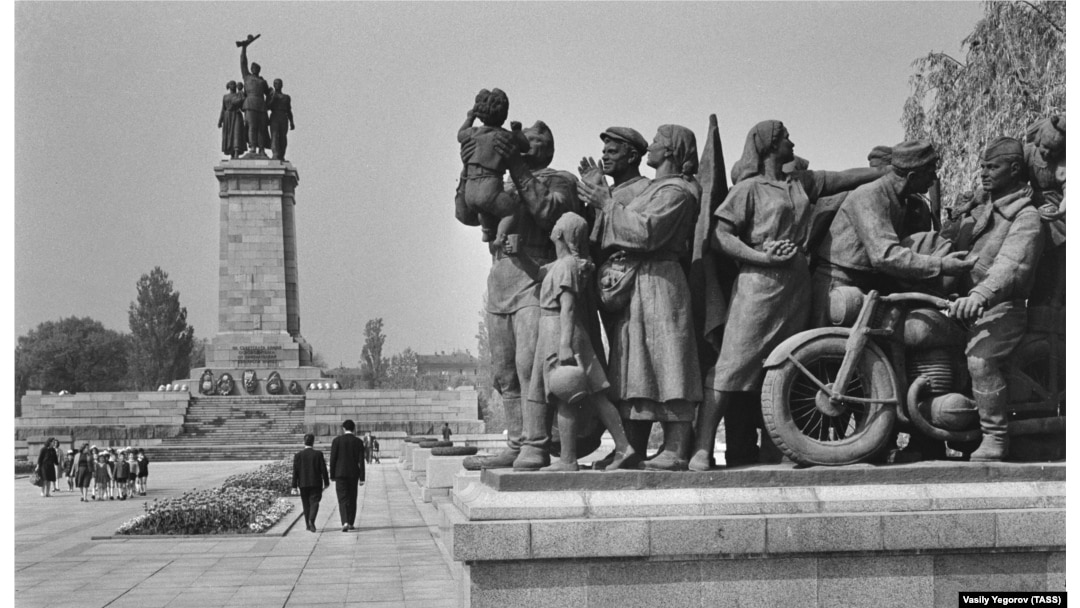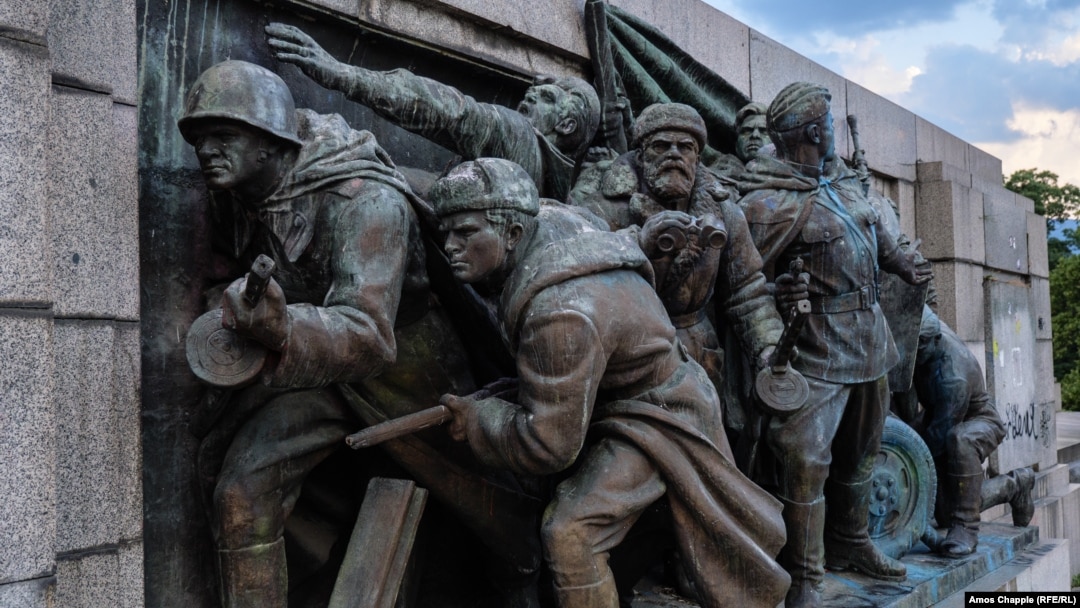SOFIA -- If a demolition crew turns up in the night to dismantle Sofia's Monument To The Soviet Army, Hristo Milev says within 30 minutes "several thousand" people will arrive to physically stop its removal.

Activists including Hristo Milev (second left) gather at the base of the Sofia monument on August 22.
Milev is one of a rotating group of activists who have watched over the towering landmark around the clock since early August, after Bulgaria's government made legal moves in recent weeks indicating the monument's removal may be imminent.
On August 17, Sofia's regional government announced a "health and safety plan" for the removal of the monument.

The Monument To The Soviet Army in 1970
The monument complex was installed in 1954, a decade after the Soviet military entered Bulgaria unopposed during World War II. The Red Army marched into Bulgaria after the country declared its neutrality following years of alignment with Nazi Germany.
The central figures of the Sofia monument show blue and yellow splashes from a paint-dropping drone attack.
Those who want it removed say the scenes of gratitude to triumphant Soviet soldiers the monument depicts are a "caricature" of history that whitewash the country's repressive Soviet-backed socialist era that lasted from shortly after World War II until 1989.
A heavily vandalized portion of the Soviet monument on August 21
The monument has repeatedly been vandalized and several recent attacks, including a drone that dropped blue and yellow paint onto the towering main figures, have shown support for Ukraine amid the ongoing Russian invasion.
Damage made to the monument on August 17 on a plaque dedicated "To the Soviet Army liberators -- from the grateful people of Bulgaria."
A group of apparent football ultras attacked the monument late on August 17, smashing a controversial, recently restored plaque with a hammer. Milev says police stationed around the monument called for backup, which arrived within around three minutes. Four people were detained after the attack.
Police watch as opponents of the Soviet monument debate with members of the protest camp on August 22.
Those who want the monument to remain point to similar landmarks glorifying the Red Army in Vienna, Berlin, and Bratislava that stand largely without controversy and are closely watched and maintained.
A section of the monument is seen with Sofia's iconic Alexander Nevsky Cathedral in the background on August 22.
Milev calls the political maneuverings over the monument a distraction. The Bulgarian government, he says, "[occupies] our minds with this so we cannot think about the big things." He pointed to key economic issues such as Bulgaria's potential adoption of the euro, which has faced strong opposition in recent months.
Nikola Andonov (second right) speaks with protesters who are watching over the monument.
On a warm evening on August 21, several debates took place between the mostly older protesters encamped at the monument and young Bulgarians passing by. Nikola Andonov was walking by with a group of friends before getting into a long and at times heated discussion with the protesters.
"They were young when the Communist Party ruled in this country, so I guess they associated it with better times in their life. So they were really trying to protect their opinion," Andonov said.
After several minutes, the student shook hands with one of the protesters and left.
"I just told them that they couldn't change my opinion and I couldn't change theirs," he said. "I've heard from people their age that just weren't OK with this totalitarian shit. So I don't know, they kind of got mad that I didn't agree with them, but at the end of the day they're older people so I had to back off."
The moon rises over the monument on August 21.
Dmitry Petkov, the organizer of the encampment at the monument, told RFE/RL the group would stay "till the end" to stop its removal. Some of the protesters believe that after local elections scheduled for late October the issue could fade from the headlines.


